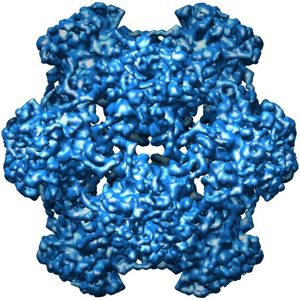

When the HPV dsDNA genome is introduced into primary human keratinocytes (PHKs), a small amount of DNA replication occurs but no infectious virus is produced. To circumvent this limitation, organotypic cell cultures called rafts were developed which enabled studies on viral replication. Raft cultures are prepared by plating PHKs on a collagen matrix containing fibroblasts; when placed at a liquid-air interface, the PHKs differentiate into a squamous epithelium. HPV replication can be studied in such cells after transfection of viral DNA, but the yields of virus particles are very low, and they cannot infect fresh cells.
In the new system, a plasmid carrying the HPV-18 DNA genome flanked by lox P sites is transfected into PHKs with a second plasmid that produces the Cre recombinase. This endonuclease cleaves the lox P sites, releasing the HPV genome from the plasmid, and viral DNA replication ensues. The cells produce high titers of progeny virus which can be used to infect fresh PHK cultures. The authors used this system to determine that viral DNA replication cannot take place while the cell is duplicating its own genome. Viral infection leads to a cessation of host DNA replication, at which time the cellular machinery is hijacked for the copying of viral genomes.
You might be wondering how the two HPV vaccines on the market, Gardasil (quadrivalent, types 6, 11, 16, 18) and Cervarix (bivalent, types 16 and 18) are produced, since their development pre-dates the high efficiency system described here. These vaccines consist of virus-like particles (VLPs), which are empty capsids that lack viral nucleic acids. The vaccines are produced by expressing in cells the viral capsid protein L1, which spontaneously assembles to form VLPs.
H.-K. Wang, A. A. Duffy, T. R. Broker, L. T. Chow (2009). Robust production and passaging of infectious HPV in squamous epithelium of primary human keratinocytes Genes & Development, 23 (2), 181-194 DOI: 10.1101/gad.1735109
D. A. Galloway (2009). Human papillomaviruses: a growing field Genes & Development, 23 (2), 138-142 DOI: 10.1101/gad.1765809

Very interesting. I never knew that such rafts are carriers of HPVs until now.
Nice information. Not exactly what I was looking for but helpful in understanding HPV
THanks
Nice information. Not exactly what I was looking for but helpful in understanding HPV
THanks
Hi Sir, good day! im a 4th year BS Chemistry student. For us to graduate, we are required to have an undergraduate thesis. The topic that I want to study is entitled “The Antiwart Activity of Ficus septica”. My problem is, how can I culture this kind of virus which is human papillomavirus (HPV) in a simplest yet best method? What is the best assay that I can do to detect the presence of this virus? I will deeply appreciate your help, comments and suggestions Sir. Thank you very much. God bless and more power
Looks like you’ve done your research very well.